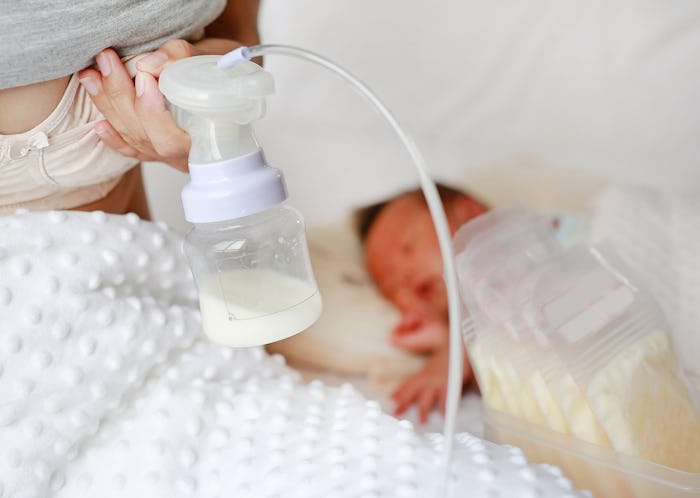Nursing your baby is one of the most rewarding experiences of being a mom, except when unexpected hurdles like mastitis make it one of the most frustrating experiences. This painful condition can seriously mess with your feeding routine, but can you pump with mastitis? You'll need to empty your breasts one way or another.
As a new mom, I was completely unprepared for just how painful nursing was in the beginning. It was so unbearably painful that I almost gave up on the idea altogether. But breastfeeding my baby was really important to me, so while I was able to power through, it definitely wasn't always smooth sailing. And if you develop conditions like m mastitis, you may feel like you're at a loss.
"Mastitis can be caused by a clogged duct that does not resolve," Andrea Tran of Breastfeeding Confidential tells Romper. Tran is a Registered Nurse and International Board Certified Lactation Consultant with over 35 years of experience helping new moms and babies.
"It causes an inflammation and progresses to an infection," she adds. "It can even progress to an abscess."
So it's important to get checked out by your doctor right away if you suspect you may have a blockage. But that's not the only condition that can lead to mastitis, as board certified pediatrician Dr. Jessica Madden tells Romper. Mastitis can also be caused by "nipple cracks and abrasions that can cause bacteria to enter the breast," and patients with this kind of infection will experience "pain, swelling and redness," often occurring in one breast.
"The affected area is usually warm to the touch. Fever, chills, and flu-like symptoms are also common," says Dr. Madden.
While Tran says mastitis is often just "bad luck," there are certain things that may put you at an increased risk for developing the condition. Things like "poor breastfeeding technique or latch, wearing a bra that is too tight, and having previously had mastitis,” may increase your chances for developing the condition, explains Dr. Madden.
So what if you're a nursing mama who has developed mastitis? Can you continue to feed and pump while you have the condition? The answer is a big yes. "Not only can you, you should," says Tran. Emptying your breasts thoroughly and regularly is important if you're experiencing mastitis, Dr. Madden agrees, noting that "breastfeeding can actually help mastitis to improve more quickly.” In fact, according to Tran, if your baby doesn't empty your breasts thoroughly during a feeding when you have mastitis, you "should use a pump after breastfeeding" to finish the job.
If it seems like your supply dips a bit during an infection, that's not your imagination... but Tran says this issue should resolve after the mastitis is gone. It might also seem like your milk looks a little funny (even "stringy"), but it's still fine to feed to your baby, says Tran.
Luckily, moms who are going through a bout of mastitis should begin feeling better 24 to 48 hours after they start antibiotics. But always check in with your doctor if you don't begin to feel better to make sure you're taking the right antibiotic for you and to rule our an abscess. (And make sure you take the whole course of antibiotics, says Tran: usually 10 to 14 days.) Give your body time to heal, and drink plenty of fluids.
Experts:
Dr. Jessica Madden, board certified pediatrician, neonatalogist and the medical director at AeroFlow Breastpumps
Andrea Tran, Registered Nurse and International Board Certified Lactation Consultant, Breastfeeding Confidential
